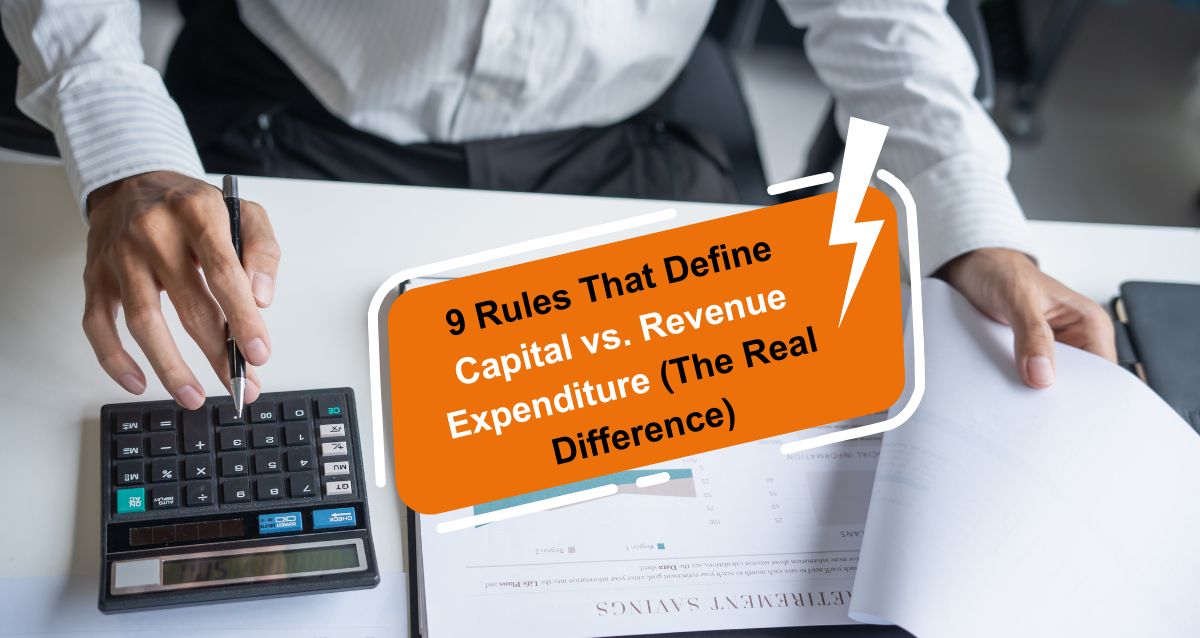9 Rules That Define Capital vs. Revenue Expenditure (The Real Difference)
Understanding how a business spends its money is crucial for long-term success. Among the most critical financial classifications are Capital Expenditures (CapEx) and Revenue Expenditures (RevEx)—two terms that often confuse even seasoned professionals. While both are essential to running and growing a business, they serve distinct purposes and have profoundly different impacts on a company’s financial statements and tax strategy.
If you’ve ever wondered whether a new laptop is an expense or an asset, or why a major factory renovation isn’t immediately deducted from profit, this guide is for you. We’ll break down the nine indispensable rules for distinguishing capital expenditure versus expense, helping you master expenditure meaning and make informed financial decisions.
Proper classification of expenditures also ensures that accurate tax information is reported to the authorities, supporting compliance and correct tax filings.
Define Expenditures: The Core Distinction
Before diving into the rules, let’s establish the expenditure meaning in business: an expenditure is simply the outlay of cash or the incurring of a liability to acquire an asset, good, or service. The classification—Capital or Revenue—depends entirely on the benefit derived from that outlay.
Capital Expenditure (CapEx)
CapEx is money spent to acquire, upgrade, or enhance a fixed asset that will provide a benefit for more than one accounting period. It is an investment in the long-term earning capacity of the business.
Revenue Expenditure (RevEx)
RevEx is money spent on the day-to-day operations and maintenance of existing assets. The benefit is entirely consumed within the current accounting period (usually one year).
Maintaining accurate data is essential for the correct classification of expenditures and to ensure compliance with tax regulations.
Classification and Record-Keeping Essentials
Accurate classification and diligent record-keeping are the backbone of effective tax compliance for any business. The Federal Tax Authority (FTA) has recognized the challenges businesses face in maintaining up-to-date tax records and has introduced a grace period, ending on March 31, 2025, to help registrants update their tax records without the risk of administrative penalties. This initiative is part of a broader effort to simplify tax procedures and encourage registrants to comply with the federal decree law on tax procedures.
During this grace period, businesses are strongly encouraged to review and update their tax records, ensuring that all information submitted to the FTA is accurate and complete. This includes verifying business details, legal entity type, and any changes in activities or trade license information. By taking advantage of this period, businesses can avoid administrative penalties that may be imposed for incorrect or outdated records after the deadline.
The FTA’s approach not only helps businesses avoid unnecessary penalties but also streamlines compliance, making it easier for registrants to meet their obligations under the federal tax authority’s regulations. Keeping tax records current is essential for demonstrating compliance, supporting tax filings, and responding to any inquiries from the FTA.
To comply, businesses should regularly review their records, update any changes in their operations, and ensure all required information is accurately reflected in their tax submissions. The FTA’s grace period is a valuable opportunity for businesses to align their practices with the latest tax procedures, reinforcing their commitment to compliance and minimizing the risk of future administrative penalties.
By prioritising the update of tax records within the specified period, businesses not only meet regulatory requirements but also position themselves for smoother interactions with the FTA and greater confidence in their ongoing tax compliance.
Rule #1: The Duration of Benefit (The Defining Factor)
The most fundamental rule that separates Capital v Revenue Expenditure is the length of time the expenditure is expected to provide value.·
CapEx Rule: If the expense generates a benefit that extends beyond the current year, it is Capital.
o Example: Buying a new piece of machinery that will operate for five years.
RevEx Rule: If the entire benefit is consumed within the current financial year, it is Revenue.
o Example: Paying this month's electricity bill or staff salaries.
This single rule dictates whether the item lands on the Balance Sheet or the Profit & Loss statement.
Rule #2: Impact on Earning Capacity
Another critical litmus test is whether the spending improves or merely maintains the business's existing capacity to generate revenue.
CapEx Rule: The expenditure either acquires a new asset or increases the earning capacity of an existing asset. This includes expanding physical space, boosting production volume, or adding entirely new product lines.
o Example: Adding a new manufacturing line to double your factory's output.
·RevEx Rule: The expenditure is incurred simply to maintain the current operating efficiency or keep the asset in its existing working condition.
o Example: Routine servicing of a company vehicle.
If the spending results in a better, faster, or bigger outcome than before, it’s CapEx. If it only restores the asset to its original condition, it’s RevEx.
Rule #3: Accounting Treatment, Corporate Tax, and Financial Statements
The classification of an expenditure directly determines how it is reported to stakeholders and tax authorities.
CapEx Rule: CapEx is capitalised. It is recorded on the Balance Sheet as a Fixed Asset. It only hits the Income Statement indirectly, gradually, through depreciation over its useful life.
RevEx Rule: RevEx is expensed. It is recorded immediately on the Profit & Loss (P&L) Account and directly reduces the company’s profit for that single financial period.
The P&L shows operational health (RevEx), while the Balance Sheet shows growth and investment health (CapEx).
It is essential to maintain accurate supporting documents for all capital and revenue expenditures to ensure compliance with tax regulations and to provide evidence in case of audits or inquiries.
Rule #4: Maintenance vs. Improvement (The Tricky Test)
This is where the line between capital expenditure versus expense often gets blurred. The distinction depends on the scope and effect of the work.
CapEx Rule: Spending that enhances, upgrades, or extends the useful life of an asset is CapEx. Think "betterment."
o Example: Replacing an asphalt roof with a durable, 50-year solar-tiled roof.
RevEx Rule: Spending that merely restores an asset to its original condition or keeps it functional is RevEx. Think "repair."
o Example: Patching a minor leak in the existing asphalt roof.
A new engine that makes a truck last another five years is CapEx; a routine oil change is RevEx.
Rule #5: Growth CapEx vs. Maintenance CapEx by Legal Entity Type
Within the realm of CapEx, sophisticated finance teams distinguish between two strategic categories. Understanding this is key to interpreting a company's investment priorities. This is the difference between growth capex vs maintenance capex.
1. Growth CapEx: Spending designed to expand the business, capacity, or market share. This is discretionary spending aimed at future revenue growth.
o Example: Building a new facility or purchasing patent rights for a new market.
2. Maintenance CapEx (or Replacement CapEx): Spending necessary to maintain the current level of operations and prevent assets from breaking down. This is non-discretionary spending.
o Example: Replacing an obsolete machine with a new one that performs the exact same function.
Both are still classified as CapEx (capitalised assets), but the internal distinction informs analysts about the company's true growth trajectory.
Rule #6: The Materiality Threshold
While the principles above are rigid, in practice, accountants use a materiality threshold to simplify bookkeeping for small, inexpensive items.
·Materiality Rule: If an asset is highly inexpensive (e.g., under a specific internal dollar limit, like $500 or $1,000) and would be a massive administrative headache to depreciate, most companies will treat it as Revenue Expenditure immediately, even if its useful life is technically longer than a year.
o Example: A $50 office printer may last three years, but the company expends it immediately as RevEx to save on tracking and depreciation costs.
This rule prioritises efficiency, but the core principle (Rule #1) is not violated—it's simply a practical compromise.
Rule #7: Impact on Taxable Income and Tax Records
The classification of spending has an immediate and direct effect on a company’s tax bill.
CapEx Rule: Because the expenditure is capitalised and expensed through depreciation, it provides a tax shield that is spread out over many years. This lowers the taxable income over the long term.
RevEx Rule: Because the entire amount is immediately expensed against current revenue, it provides a large, immediate tax deduction in the year the expense occurred.
Managers often prefer RevEx for immediate tax savings, while investors generally favor CapEx as it signals long-term investment.
Accurate classification of expenditures is also essential for the correct calculation and payment of taxes, ensuring compliance with all relevant tax regulations.
Rule #8: Funding Source Preference and Federal Tax Authority Considerations
The way management funds the expenditure can sometimes provide a hint as to its nature, especially when looking at the Cash Flow Statement.
CapEx Rule: Often funded by long-term financing (loans, debt, or equity) and appears under Investing Activities on the Cash Flow Statement.
RevEx Rule: Funded by the business's operating cash flow and appears under Operating Activities on the Cash Flow Statement.
While not a rule of classification itself, where the cash flows from is a major characteristic of capital vs revenue expenses
Rule #9: Depreciation is a Tell-Tale Sign
The act of applying depreciation is the final piece of evidence confirming that an expenditure was classified as Capital.
Depreciation Rule: If an asset is subject to systematic depreciation or amortisation, it was first classified as a Capital Expenditure. This process systematically allocates the cost of the asset to the periods in which the asset is used to generate revenue (matching principle).
No Depreciation Rule: Revenue expenditures (RevEx) are not depreciated. They are simply recorded as a one-time charge against income.
This process ensures that the financial statements accurately reflect the cost of the asset over its actual period of use, providing a true picture of profitability.
Conclusion: Making Smarter Financial Decisions
Mastering the difference between Capital v Revenue Expenditure is not merely an accounting exercise; it is a fundamental skill for strategic business management. Misclassifying an expense can lead to overstated profits (by recording CapEx as RevEx) or understated assets (by recording RevEx as CapEx), leading to incorrect tax liabilities and misguided investment decisions.
By applying these nine indispensable rules—focusing on benefit duration, impact on capacity, and proper accounting treatment—you ensure your financial statements provide a true and fair view of your company's performance, driving both operational efficiency and long-term asset growth.
Would you like a breakdown of how the new UAE Corporate Tax laws treat CapEx depreciation versus RevEx deductions?
The core distinction between Capital Expenditure (CapEx) and Revenue Expenditure (RevEx) hinges on the duration of the benefit. CapEx is an investment used to acquire or significantly enhance assets (like machinery or buildings) that yield benefits over multiple years, and is therefore recorded on the Balance Sheet. Conversely, RevEx is a routine operating cost (like salaries or rent) consumed within the current year, and is immediately charged against profit on the Income Statement. Misclassification drastically impacts financial reporting, profitability, and long-term tax liabilities (CapEx is depreciated; RevEx is immediately deducted).
How Flyingcolour Tax Consultant can help?
Flyingcolour Tax Consultant provides expert consulting to ensure the accurate classification of all your expenditures. We help businesses navigate the complexity of CapEx vs. RevEx rules to ensure financial statements are compliant, optimize your annual tax deductions (both depreciation and operating expenses), and prevent costly misstatements that could lead to penalties or misinformed strategic decisions.
To learn more about The Real Difference: 9 Indispensable Rules for CapEx vs. Revenue Spending, book a free consultation with one of the Flyingcolour team advisors.
Disclaimer: The information provided in this blog is based on our understanding of current tax laws and regulations. It is intended for general informational purposes only and does not constitute professional tax advice, consultation, or representation. The author and publisher are not responsible for any errors or omissions, or for any actions taken based on the information contained in this blog.


